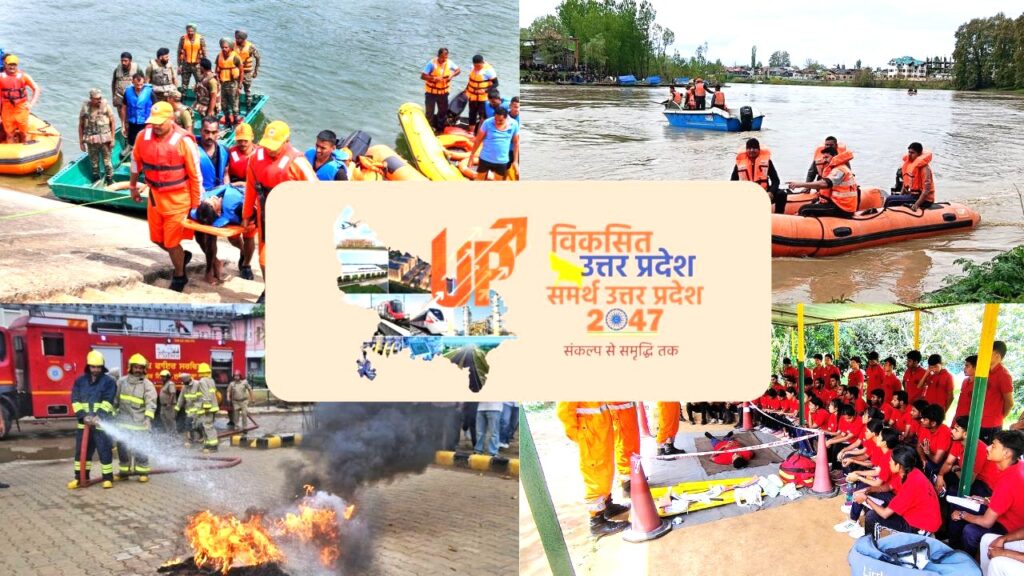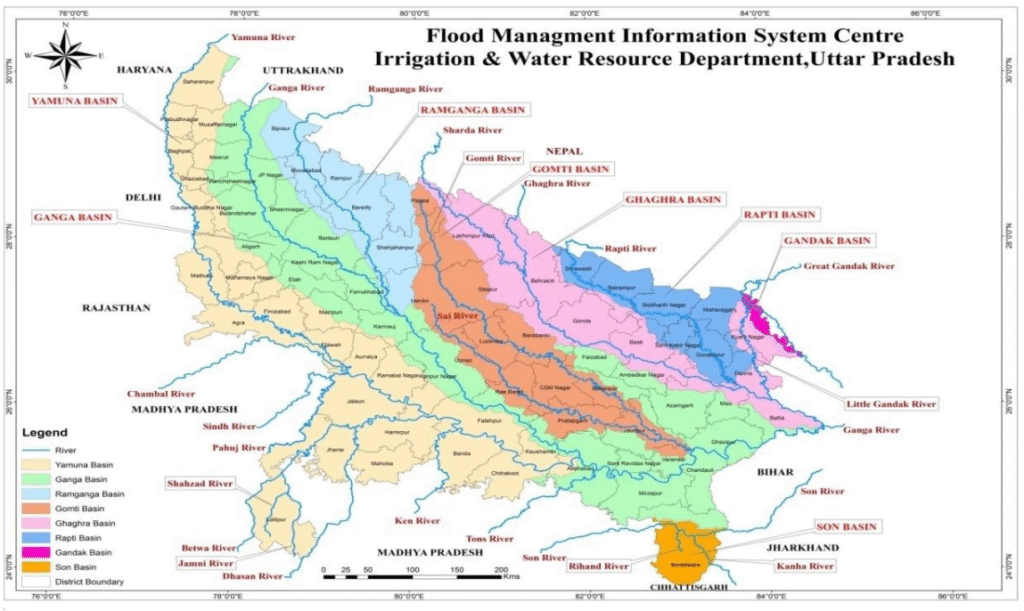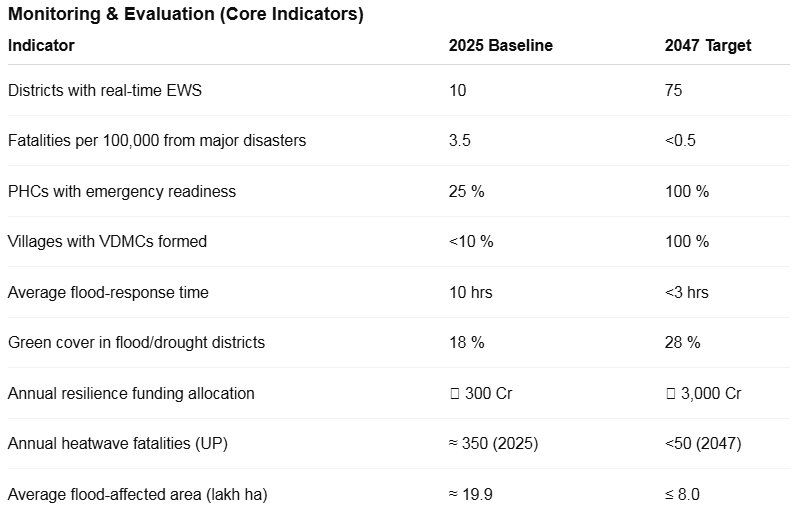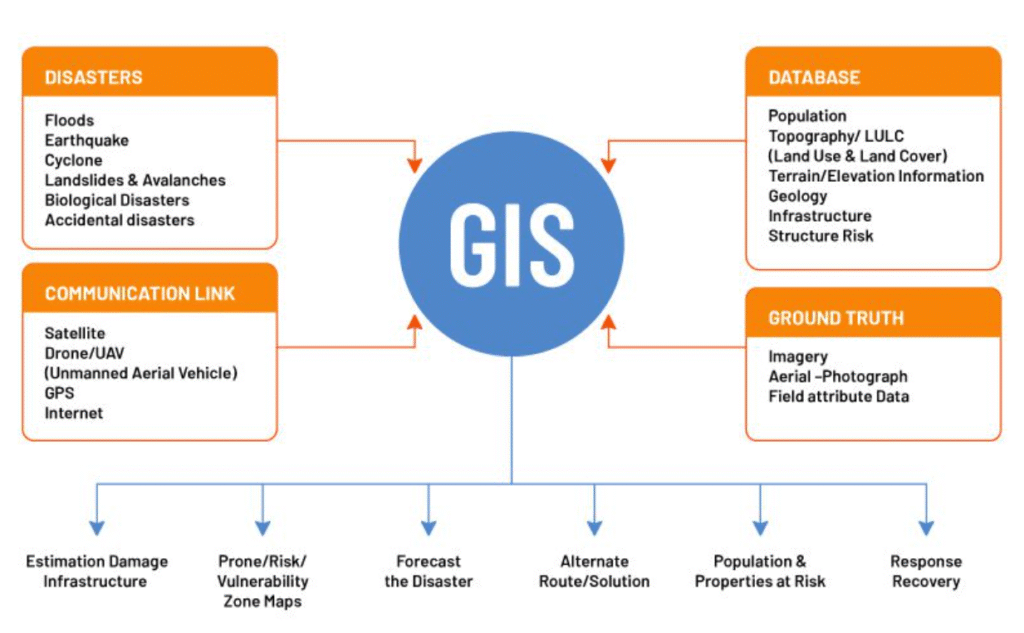
The state of Uttar Pradesh (UP) stands at a critical juncture. With over 240.93 lakh ha and recurring exposure to floods, droughts, heatwaves, seismic shocks and epidemics, UP’s disaster-risk profile demands ambition, innovation and sustained effort.
Against this backdrop, the proposed “Disaster Resilience Vision 2047,” prepared by me, presents a bold roadmap. It envisions a future where every community is prepared, every system is predictive, and every investment contributes to reducing disaster risk.
In this blog, we unpack:
- the current hazard & vulnerability context of UP
- the six strategic pillars of the vision
- the phased deliverables (2026-2047) for building resilience
- flagship cross-sector initiatives, financing, and monitoring
- the path ahead and what it means for citizens, communities & governance
1. Hazard Landscape: Why UP Needs Resilience
Multi-Hazard Profile
UP is officially recognised as a multi-hazard state: floods, droughts, earthquakes, heat/cold waves and lightning are all significant risks. The state disaster profile notes flooding affects approximately 27 lakh ha annually, with severe crop and livelihood losses.
A detailed nationwide analysis found that from 1995–2020, flood-related deaths were highest in UP among Indian states.
Drivers of Risk
- Climate change: More intense rainfall, shifting monsoon patterns, increasing temperatures and associated hazards such as heatwaves and lightning.
- Exposure & vulnerability: High population density, large rural-agricultural workforce, expansive floodplains of rivers like the Ganga, Ghaghra, Rapti, Yamuna.
- Development gaps: Infrastructure that is not climate-proof, weak early-warning & data systems, patchy community preparedness.
- Fragmented governance: Disaster response still largely reactive rather than anticipatory. The need for integration of risk into development is repeatedly stressed.
Why 2047 Matters
With India looking ahead to “Viksit Bharat 2047”, aligning UP’s resilience ambitions with national goals is both timely and necessary. This vision aims to shift the paradigm from “Respond & Recover” to “Predict – Prepare – Prevent”.

2. Strategic Pillars of the Vision
The vision rests on six strategic pillars – each of which addresses a key dimension of disaster resilience.
- Predictive Governance
Moving from reactive response to data-driven, AI-assisted decision-making. This means leveraging real-time inputs from India Meteorological Department (IMD), Central Water Commission (CWC), remote-sensing/GIS platforms and integrating across departments. - Resilient Infrastructure
Climate-proofing critical facilities (housing, schools, hospitals, bridges) across all 75 districts. Ensuring built-environment adapts to shocks and stresses. - Empowered Communities
Every Gram Panchayat to have trained volunteers, local early-warning systems, and micro-plans for resilience. The heart of bottom-up transformation. - Green & Blue Infrastructure
Rivers, wetlands and watersheds restored to serve as natural buffers — for floods, droughts and heat. Emphasises nature-based solutions. - Institutional Continuity
Embedding disaster resilience into the planning and budgets of all departments by 2035 — mainstreaming risk in governance. - Zero Casualty & Zero Loss by 2047
Ambitious, but visionary: moving to a future where development investment reduces risk, rather than adding to it.
3. Phase-Wise Deliverables (2026-2047)
Phase 1 (2026-2027): Foundation — Data, Knowledge & Governance
- Deliverable 1: State Disaster Resilience Framework 2047 – aligning UP’s targets with the Sendai Framework for Disaster Risk Reduction (2015-2030) and national goals.
- Deliverable 2: Multi-Hazard Vulnerability Atlas (flood, drought, seismic, heatwave, lightning, epidemic) in digital + print form; annual updates via ISRO/state remote-sensing.
- Deliverable 3: District Disaster Resilience Index (DDRI) – ranking all 75 districts on exposure, preparedness and recovery capacity.
- Deliverable 4: UP Disaster Knowledge Portal – central repository for data, SOPs, best practice and your 16-chapter compendium.
Phase 2 (2027-2032): Innovation & Integration — Smart Systems
- Deliverable 5: AI-powered Early Warning & Forecast-Based Action Platform — integrating IMD, CWC, Health & Agriculture datasets; piloted in districts like Bahraich, Gorakhpur, Banda, Lucknow.
- Deliverable 6: Integrated Command & Resilience Centres (ICRCs) — upgraded district control rooms with GIS dashboards, satellite connectivity.
- Deliverable 7: Statewide Community Based Disaster Risk Management (CBDRM) Programme — “One Village – One Disaster Mitra Team”; target: all 58,000 Gram Panchayats trained by 2030.
Phase 3 (2032-2037): Resilient Infrastructure & Ecosystem Restoration
- Deliverable 8: Resilient Infrastructure Mission (RIM-UP) – retrofitting 10,000+ critical facilities (schools, PHCs, bridges, panchayat offices).
- Deliverable 9: Nature-Based Solutions for Flood & Drought Management – inspired by the Netherlands’ “Room for the River” and India’s Namami Gange initiative.
- Deliverable 10: Smart Urban Resilience Plan – for Tier-II cities (Lucknow, Kanpur, Prayagraj, Varanasi, Gorakhpur) focusing on urban flood control, heat action plans, waste-water audits.
Phase 4 (2037-2042): Community Empowerment & Behavioural Change
- Deliverable 11: School & College Safety Programme – institutionalising disaster education and mock-drills, launching “Resilient School Index”.
- Deliverable 12: Resilient Gram Panchayat Programme – Annual “Resilience Plans” aligned with Finance Commission grants.
- Deliverable 13: Statewide IEC (Information, Education, Communication) Campaign — “Surakshit Uttar Pradesh” focusing on lightning, snakebite, heat & flood preparedness via TV, radio & digital.
Phase 5 (2042-2047): Institutionalisation & Legacy
- Deliverable 14: UP Resilience Mission Act – state legislation mainstreaming disaster risk reduction in departmental planning.
- Deliverable 15: UP Resilience Cell & Innovation Fund – a permanent research cell under the Relief Commissioner supporting AI pilots and academia partnerships (IIT Kanpur, BHU, TERI, NIDM).
- Deliverable 16: Annual UP State of Resilience Report – yearly assessment beginning 2027, culminating in a Resilience Year-book in 2047.
4. Cross-Sectoral Flagship Initiatives

These initiatives integrate seamlessly into the vision’s pillars — linking infrastructure, community, governance and nature-based approaches. For instance, lightning-resilient village networks support “Empowered Communities”; climate-smart farm clusters support “Green & Blue Infrastructure” and resilient livelihoods.
5. Financing, Partnerships & Monitoring
Financing Streams
The vision anticipates leveraging a mix of national and multilateral sources:
- State Disaster Response Fund (SDRF) / State Disaster Mitigation Fund (SDMF)
- NABARD, National Water Mission, Jal Jeevan Mission, NRLM
- Smart Cities Mission, World Bank, ADB, UNDP, Green Climate Fund (GCF)
Partnerships
Key institutional partnerships include:
Indian Institute of Technology Kanpur | Banaras Hindu University | The Energy & Resources Institute (TERI) | National Institute of Disaster Management (NIDM) | Indian Space Research Organisation (ISRO) | IMD | CWC | National Disaster Management Authority (NDMA) | Indian Red Cross Society | CARE | SEEDS India – building a multi-stakeholder ecosystem.
Monitoring & Evaluation (Core Indicators)

6. What This Means for Stakeholders
For Communities & Panchayats
- Local resilience micro-plans become the norm.
- Community volunteers, early-warning alerts, drills and preparedness become embedded.
- Nature-based protection (wetlands, buffer zones) safeguard livelihoods and homes.
For Infrastructure & Urban/ Rural Development
- All critical facilities (schools, hospitals, bridges) will be built or retrofitted with climate resilience in mind.
- Urban areas will adopt flood-/heat-/waste-resilience as core to planning.
- Rural farm clusters adopt climate-smart practices, reducing yield loss and risk.
For Governance & Data Systems
- Data-driven decision making: real-time inputs from IMD, CWC, ISRO, GIS coupled with AI to trigger action.
- Disaster-risk becomes part of each departmental budget and plan, hence institutional continuity.
- Transparency and accountability: annual State of Resilience Reports, district rankings, dashboards.
For Financing & Partnerships
- Multi-source financing enables large-scale investments in resilience, covering not only relief but prevention.
- Academia, tech-partners, international agencies and states converge to pilot and scale innovations.
- Development shifts to risk-sensitive investments rather than adding to hazard exposure.

7. Challenges & Pointers for Implementation
- Data availability & quality: baseline hazard, exposure and vulnerability data needs strengthening. The DST-led mapping shows this clearly.
- Capacity at district/gram-panchayat level: Upskilling, resources and institutional support will be key.
- Mainstreaming across departments: Disaster-risk often sits in one silo. Breaking down silos is essential.
- Behaviour change: Community empowerment requires consistent IEC campaigns, drills, local ownership.
- Funding & continuity: Ensuring that initial momentum (2026-2027) translates into sustained investment through 2047.
- Monitoring & evaluation rigor: Transparent tracking of indicators, peer review, public dashboards will drive accountability.
Way Ahead: Putting the Vision into Motion
- Publish and disseminate the Resilience Roadmap 2047 and engage all stakeholders (state agencies, districts, Panchayats, civil society).
- Launch the Multi-Hazard Vulnerability Atlas and DDRI in 2026, enabling data-driven prioritisation of districts.
- Pilot early-warning and AI platforms in selected districts (e.g., Bahraich, Gorakhpur) by 2028 as proof-of-concept.
- Begin retrofitting critical infrastructure by 2032 under the Resilient Infrastructure Mission.
- Institute annual “UP State of Resilience” Reports starting 2027, publicly available, feeding into policy and budget cycles.
- Engage communities through the “Disaster Mitra” model, ensuring every Gram Panchayat is transformed by 2030.
- Finally, campaign for the UP Resilience Mission Act by 2042 to enshrine these reforms into law.
Conclusion:
This is more than a policy document – it is a strategic research, innovation and knowledge package aimed at shifting UP’s trajectory. By 2047, the goal is nothing less than: zero preventable disaster deaths, climate-smart development, and resilient governance.
If fully implemented, Uttar Pradesh has the potential to become India’s most disaster-ready state, serving as a model globally for large-population states facing multi-hazard risk.







